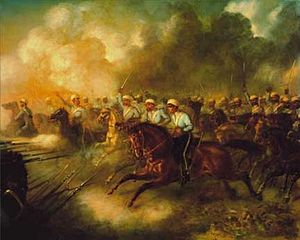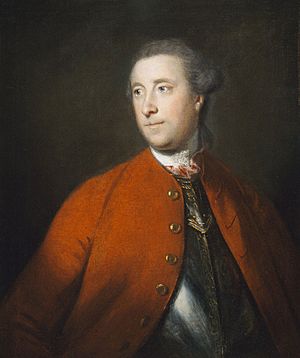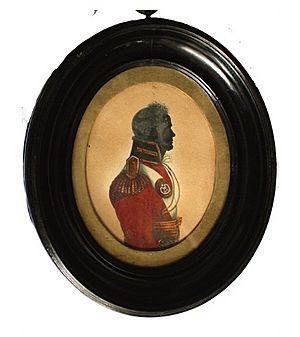64th (2nd Staffordshire) Regiment of Foot facts for kids
Quick facts for kids 64th (2nd Staffordshire) Regiment of Foot |
|
|---|---|
| Active | 10 December 1756–1 July 1881 |
| Country | |
| Branch | |
| Type | Infantry |
| Role | Line Infantry |
| Size | One battalion |
| Garrison/HQ | Whittington Barracks, Staffordshire |
| Nickname(s) | The Black Knots |
| Colors | Black facings |
| March | Romaika |
| Engagements | Seven Years' War, American War of Independence, Napoleonic Wars, Anglo-Persian War, Indian Rebellion |
| Battle honours | Guadeloupe 1759; Martinique 1794; St Lucia 1803; Surinam; Reshire; Bushire; Koosh-Ab; Persia; Lucknow |
| Disbanded | 1881, amalgamated with 98th Foot to become The Prince of Wales's (North Staffordshire) Regiment |
The 64th (2nd Staffordshire) Regiment of Foot was a group of foot soldiers, also known as infantry, in the British Army. This regiment was first formed in 1756 as the 2nd Battalion of the 11th Regiment of Foot. Two years later, in 1758, it became its own group called the 64th Regiment of Foot.
Later, in 1782, it added a county name and became the 64th (2nd Staffordshire) Regiment of Foot. This linked them to the area of Staffordshire in England. In 1881, the 64th Regiment joined with another group, the 98th (Prince of Wales's) Regiment of Foot. Together, they became a new regiment called The Prince of Wales's (North Staffordshire Regiment). The 64th Foot became the 1st Battalion of this new group because it was older.
Even though the 64th Foot fought in many big wars in the late 1700s and early 1800s, they often served in smaller parts of these conflicts. For example, during the Seven Years' War and the Napoleonic Wars, they mostly fought in the West Indies and South America. In the mid-1800s, they took part in the Anglo-Persian War and the Indian Rebellion of 1857. During the Indian Rebellion, one of their soldiers even won the Victoria Cross, a very brave award.
The 64th Regiment: A British Army Story
How the Regiment Started
The 64th Foot was created because the British Army needed more soldiers for the Seven Years' War. On August 25, 1756, an order was given for some existing regiments to create a second group of soldiers, called a battalion. The 11th Regiment of Foot was one of these.
The 2nd Battalion of the 11th Foot was formed in Southampton, England, on December 10, 1756. It then moved to Newcastle upon Tyne. On April 21, 1758, the War Office decided that these second battalions should become their own independent regiments. So, the 2nd Battalion 11th Foot became the 64th Foot.
Soon after, King George II ordered that the 64th Foot and other new regiments should have their start date moved back to when they were first formed as second battalions. This meant the 64th Foot's official start date became 1756. The first leader, or colonel, of the regiment was John Barrington. He chose black as the color for the regiment's uniform details, called "facings."
Early Adventures: Seven Years' War
Right after becoming the 64th Foot, the regiment was sent to the West Indies. In 1759, they tried to capture Martinique, but it wasn't successful. Then, they took part in the successful invasion of Guadeloupe. This action earned them their first special award, a battle honour called Guadaloupe 1759. However, they didn't officially receive this award until 1909.
The regiment returned to England in June 1759. They had lost many soldiers because some were moved to other units, and many got sick from tropical diseases. When they arrived in Portsmouth, only 137 soldiers were healthy enough to fight out of 790. The officers were mostly fine. It took a long time for the regiment to get back to full strength. They spent three years in Scotland and five years in Ireland before sailing to North America in 1768.
Fighting in America: American War of Independence

The 64th Regiment's first stop in America was Boston. At that time, Boston was a place with a lot of unhappiness and protests against British rule. In 1770, the regiment moved to Halifax, Nova Scotia, but they returned to Boston in 1772. They were stationed at Castle William.
As the unrest grew, the 64th Regiment was involved in an event that some say was the first bloodshed of the American War of Independence. On February 26, 1775, the 64th, led by Lieutenant Colonel Alexander Leslie, was ordered to seize weapons and ammunition in Salem, Massachusetts. American patriots in Salem knew they were coming and tried to stop them. During a struggle, a local man named Joseph Whicher was slightly hurt by a British bayonet. Luckily, talks prevented more fighting, and the 64th went back to Boston without completing their mission.
When the war officially started in April 1775, the 64th was still at Castle William. They stayed there as the guards during the Siege of Boston. Because of this, they didn't fight in the Battle of Bunker Hill. In March 1776, when the British left Boston, the 64th was the last British regiment to leave for Halifax. This means they were the last British soldiers to be in Commonwealth of Massachusetts during the war.
The army was reorganized, and the 64th, like most regiments, had its special "flank companies" (grenadier and light infantry) separated to form other battalions. All three groups fought in the 1776 capture of New York. The 64th also fought in the Battle of Ridgefield.
In 1777, all three units took part in the Philadelphia campaign. They fought in the Battle of Brandywine, the Battle of Paoli, and the Battle of Germantown. They stayed in Philadelphia through the winter of 1778. When Lieutenant-General Clinton left the city in June 1778, the 64th and the 2nd Grenadier Battalion were part of the group protecting the rear. Back in New York, the 64th was involved in several smaller operations. One of their light companies was in a fight known as the Baylor Massacre.
In November 1779, all the companies of the regiment moved to the southern part of the war. In April 1780, the 64th helped surround Charleston, while the grenadier and light companies were part of the main attack force. After Charleston was captured, the grenadier and light companies went back to New York. As Major-General Cornwallis moved towards Virginia, the 64th stayed in Carolina as guard troops. In 1781, the 64th fought in the Battle of Eutaw Springs. A year later, they were in one of the last fights of the war, the Battle of the Combahee River. The grenadier company rejoined the 64th, but the light company was among the units that surrendered with Cornwallis at Yorktown.
In December 1782, the regiment left America for Jamaica. Back in England, the army changed its policy to try and get more people to join. Infantry regiments were given extra names linked to areas. The 64th became the 64th (2nd Staffordshire) Foot. This started their long connection with the city of Lichfield. Their training base moved there, and soon they began to wear the Staffordshire Knot symbol on their uniforms.
Napoleonic Wars and West Indies Campaigns
After the defeat in America, the 64th stayed in Jamaica for two years, returning to England in 1783. Four years later, the regiment was in Ireland. Then, in 1793, at the start of the Napoleonic Wars, they sailed back to the West Indies. At the end of the Seven Years' War, Martinique and Guadeloupe had been given back to France.
From Barbados, the 64th Foot took part in the invasion of Martinique in early 1794. Again, the special flank companies were separated, but all parts of the regiment were involved in the fighting there. This quick and successful campaign earned the regiment its second battle honour, Martinique 1794. Like the Guadeloupe honour, this was not officially awarded until 1909.
The light and grenadier companies then helped capture St Lucia and recapture Guadeloupe. After a short time guarding these islands, the regiment returned to England. They were very weak from battle losses and sickness, especially yellow fever. The British commander, Sir Charles Grey, estimated he had lost 5,000 out of 7,000 soldiers in less than six months.
The regiment returned to England in 1795. They then moved to Gibraltar and later to Ireland, where they played a small part in stopping the 1798 rebellion. The 64th came back to England in 1800.
Within months, the 64th was back in the West Indies. They were part of a campaign to take islands held by France, the Netherlands, and Denmark. They first captured the island of Saint Martin. Then came the Dutch island of St Eustatius and the Danish islands of Saint Thomas, Saint John, and Saint Croix.
When the Treaty of Amiens was signed, which gave back all conquered lands to France and its allies, the 64th moved to Barbados. But peace didn't last long. In 1803, war with France started again. The 64th immediately went into action, helping to capture St Lucia. This earned them the battle honour St Lucia 1803, which was awarded more quickly in 1818. The expedition continued to South America, capturing Dutch-held Surinam in 1804. A fourth battle honour, Surinam, was also awarded in 1818. The 64th stayed in Surinam for the next nine years, mostly on guard duty. This meant they didn't take part in any more major Napoleonic Wars battles.
In 1813, the 64th moved to Halifax, Nova Scotia. There, they provided the funeral guard for James Lawrence, the Captain of the USS Chesapeake, after the British captured his ship. In 1815, the regiment returned to Europe. They were sent to France as part of the army that occupied the country after the Battle of Waterloo.
Years of Peace and a Shipwreck Story
The regiment didn't see active fighting again until 1856. Before that, they had a short time in England, a long stay in Gibraltar, several years in Ireland, and another six-year tour in the West Indies. In the West Indies, many soldiers suffered from fever again.
After that, they had a short three-year tour in Canada. During the trip home from Canada, something interesting happened. Two companies of soldiers, led by Captain James Draper, along with about 100 women and children, were on a ship called the Alert. The ship hit a reef about 100 miles from Halifax. The ship floated again, but in rough seas, it was taking on water and was at risk of sinking.
The ship's captain decided the only option was to beach the vessel. However, he was worried the ship was becoming too heavy at the top because everyone was moving to the upper deck. Captain Draper and his soldiers were convinced to stay on the troop deck, even though the water level was rising there. The ship was successfully beached on an uninhabited island, and everyone on board was later rescued.
The Duke of Wellington, who was the Commander-in-chief of the British army, ordered that the story of Captain Draper's group be read to every regiment in the army. It was an example of how important steadiness and discipline were. The two companies rejoined the rest of the regiment in England. They served in England and Ireland before being sent to India. They were based in India until 1856 but didn't see any active service there.
Anglo-Persian War and Indian Rebellion

War broke out between Britain and Persia in 1856. The 64th, along with the 20th Bombay Native Infantry, formed the 1st Brigade in the army sent for the campaign. They landed in Persia in late November. The regiment fought in battles at Reshire and Bushire. In 1857, the army moved inland and defeated the Persian army at Koosh-Ab on February 8, 1857. The flank companies were also involved in fighting at Ahwaz.
Even though the fighting lasted only a little over three months, four battle honours were awarded: Reshire, Bushire, Koosh-Ab, and Persia. The 64th was the only British regiment to receive all four.
After the Persian campaign, the 64th returned to India. They arrived in Bombay just two weeks after the first unrest began in Meerut. The regiment was immediately ordered to join the force going to help Cawnpore, led by Major-General Sir Henry Havelock.
The relief force didn't reach Cawnpore before the city fell to the rebels. So, a forced march was ordered. The first clash with the rebel forces happened at Fatehpur. From there, several small fights took place until the force met the rebels in a big battle at Ahwera on July 16. It was for his actions in this battle that Lieutenant Henry Havelock of the 10th Foot won the Victoria Cross.
This award caused some unhappiness within the 64th. The award description suggested that the regiment only advanced because of Lieutenant Havelock's actions. The matter was brought to Sir Colin Campbell, the Commander in Chief in India. He agreed with the complaint and strongly criticized staff officers (Havelock was helping his father) for getting in the way of regimental officers doing their duty. The relief force entered Cawnpore on July 17, 1857.
Later, some parts of the regiment played a small role in the relief of Lucknow. But most of the regiment stayed in Cawnpore. It was here, on November 28, 1857, that Drummer Thomas Flinn won the only Victoria Cross awarded to a member of the 64th Regiment. He bravely tackled two enemy artillerymen even though he had been wounded himself. After this, the regiment moved to Fatehgarh and stayed there for the rest of the campaign until June 1859, when they returned to Bombay. The regiment was awarded a single battle honour: Lucknow.
Final Years and Joining Forces
When the regiment returned from India in 1861, they spent six years in England. They moved to Malta in 1867, then to Ireland in 1872. In 1874, as part of the Cardwell Reforms (changes to the army), infantry battalions were linked in pairs. The 64th formed a joint training base with the 98th (Prince of Wales's) Regiment of Foot at Limerick. These two regiments were assigned as district no. 20, with a new base at Whittington Barracks, Staffordshire, in 1880.
Until 1879, the 64th was stationed in different parts of the United Kingdom, often helping with police duties. The regiment returned to Ireland in 1879, based at Templemore, County Tipperary. They were there when they officially joined with the 98th to become the Prince of Wales's (North Staffordshire) Regiment on July 1, 1881.
The regiment was renamed The North Staffordshire (The Prince of Wales's) Regiment in 1920. In 1959, the North Staffordshire and South Staffordshire Regiments joined together to form The Staffordshire Regiment (The Prince of Wales's). In September 2007, The Staffordshire Regiment joined with the Cheshire Regiment and the Worcestershire and Sherwood Foresters Regiment to form The Mercian Regiment. In this new regiment, the Staffords became the 3rd (Staffordshire) Battalion.
The black uniform details, or "facings," worn by the 64th Foot are still remembered today. All Warrant Officers and Non-commissioned officers of the Mercian Regiment now use black backing for their rank badges.
Battle Honours
These are the special awards the regiment received for their bravery in battles:
- Guadaloupe 1759, Martinique 1794 (both awarded in 1909)
- St. Lucia 1803, Surinam
- Anglo-Persian War: Reshire, Bushire, Koosh-Ab, Persia
- Indian Mutiny: Lucknow
|



